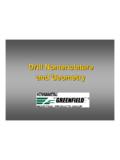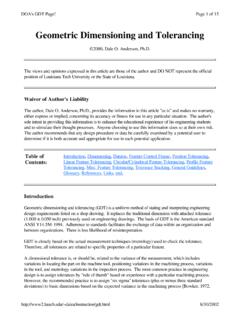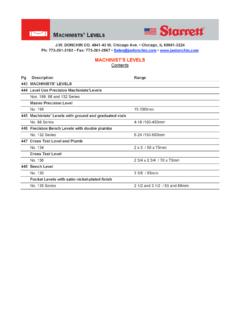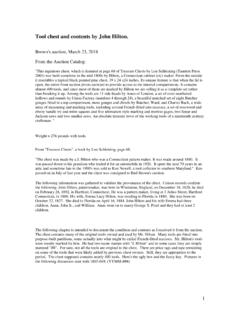Transcription of NIMS Machining Level I Preparation Guide - NEMES
1 nims Machining Level I Preparation Guide Measurement, Materials, and Safety Table of Contents Overview pages 2 - 5 Introduction page 2 Who Wrote the Questions page 2 How to Prepare for the Credentialing Exam page 3 Areas of Knowledge Measured by the Exam pages 3 - 4
2 Before the Exam page 4 At the Testing Site page 5 Machining Exam Measurement, Materials, and Safety pages 6 - 27 Exam content and Sample Question Overview page 6 Exam Specifications page 7 Task List pages 8 - 23 Sample Test pages 8 - 23 Answer Key pages
3 24 - 27 2003 National Institute for Metalworking Skills, Inc. Page 1 of 27 Overview Introduction This Preparation Guide or test advisor is intended to help machinists study and prepare for the National Institute for Metalworking Skills ( nims ) written credentialing exam. The sample test will help prepare machinists to take the actual credentialing exam. None of the questions are duplicates from the actual exam. However, this Preparation Guide is a useful tool for reviewing technical knowledge and identifying areas of strength and deficiency so that the student has what is needed to do well on the exam.
4 Achieving a nims credential is a means through which machinists can prove their abilities to themselves, to their instructors or employers and to the customer. By passing the nims credentialing exam you will earn a valuable and portable credential. Because the exam is tough, you will have the satisfaction of proving to yourself and others that you have reached a Level of competency that is accepted nationally. Who Wrote the Questions A panel of technical experts, from all areas of the metalworking industry, wrote the questions used on the actual credentialing exam. The panel of experts ranged from company presidents and owners, to engineers and quality personnel, to actual working machinists.
5 Exam questions are designed to test the knowledge skills needed for entry- Level machinists. They are written to deal with practical problems, computations, and decisions machinists encounter in their day-to-day work. The technical experts must first validate the exam questions. Then, before the questions become part of the credentialing exam, qualified machinists and industry personnel again validate them on a national Level . Rejected questions are then rewritten or discarded altogether. Page 2 of 27 How to Prepare for the Credentialing Exam Become familiar with the exam content and question format by utilizing the tools provided in this test Preparation Guide .
6 The Exam Specifications portion of this Guide contains a summary description of the content covered by the actual credentialing exam. The Task List describes competencies for each particular area associated with the credentialing area. Each question on the sample test is linked to a particular task or set of tasks found in the Task List. Therefore, a review of the Task List, with an eye on judging whether you know how to perform each task listed, will provide you with valuable information as you prepare for the exam. The questions are multiple-choice. Note instructions that may accompany some questions. Be sure to read each question carefully (twice, if necessary) so that you know exactly what is being asked.
7 Check each answer and your work since an error in computation or understanding may make a wrong answer appear correct. The following four steps are suggested for effective Preparation : Step 1: Study the content list for each exam you will attempt. Step 2: Carefully read the Task List for each section. Step 3: Review the sample test to become familiar with subject matter and question type. This is a very important step. Step 4: Repeat steps 1 through 3 and identify the area(s) where you need additional study. Use the Preparation Guide as a self-diagnostic tool. Areas of Knowledge Measured by the Exam The knowledge and skills you will need to pass the credentialing exam are as follows: Exam Sections The exam is divided into four sections.
8 They are: General Maintenance Tasks Industrial Safety & Environmental Protection Tasks Quality Control and Inspection Tasks Page 3 of 27 Process Adjustment and Improvement Tasks Following is a list of the basic knowledge areas assessed by the exam: Applying the Machinery s Handbook: The machinist must be able to reference and apply information found in the handbook to solve application problems. Referencing thread percentage, finish symbols, and allowances are some of the skills required. Basic Mathematics: The exam will assess basic math knowledge of fraction/decimal conversion, addition and subtraction of decimals, and an understanding of percent.
9 Industrial Safety: The machinist must become familiar with Hazmat, MSDS, basic personal protective equipment (PPE), and machine tool safety. Student assessment includes identification of a government body that regulates industrial safety Occupational Safety and Health Administration (OSHA). Maintenance: Student assessment includes elementary knowledge of referencing and researching maintenance procedures, hand tool maintenance and safety, and simple tool maintenance. Process Adjustment: The exam presents basic problems of Machining processes such as tapping, threading, drilling, milling, reaming, and grinding in which a process adjustment functions as the corrective action.
10 Students must identify a basic goal of process improvement. Quality Control Procedures: The exam will evaluate knowledge of basic concepts of SPC and sampling plans. Basic knowledge of inspection plans includes rationale, criteria for choosing the correct measuring instrument, and organization. The evaluation includes basic knowledge of inspection setups and measuring instruments. Before the Exam Page 4 of 27 Try to be well rested for the exam. Being well rested will make you more alert and efficient when taking the credentialing exam. Review any course material from your instructor. Review the test advisor information and sample test.












